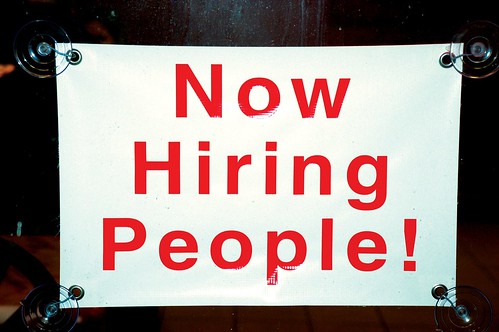New concrete example of socialization : the recruitment process. Here again, we’ll see that it’s possible to do things without Copernican Revolution or harming anyone.
The situation
Enterprises have to hire people. Even if the market is sometimes hard for applicants, no company can work without people. The need is clear : hiring people who fit both the job description and the corporate culture, in the shorter time. If all these conditions are met, there is a kind of economic optimum : the right person according to the job means he/she will help value creation, compliance with culture means that he/she won’t leave after a few months (what implies a lot of extra costs), and as soon as possible means that internal costs will be as low as possible.
A structured approach that’s not infallible
From the job definition to the hiring, there’s no place for luck. A good recruitment is a challenge that’s important enough not to be treated in an offhand manner. Large businesses have a clear methodology to source and select applicants. Impossible to bypass it. This is logical since many of them have quality certified process, what means “we write what we do and we do what we write”. More, if everyone does things his own way, things may be confused if not unmanageable at the enterprise scale.
But sometimes it’s not egnough. Said in other words, the official method may fail to deliver the expected results. This may happen for many reasons. For instance : need to hire someone in emergency (sourcing is too slow), need for a specific or new kind of profile (not necessarily a big name, but there is an increasing need for new profiles that HR dept are not comfortable with yet, can’t source and qualify as well as traditional profiles), lack of applicants…. Of course it’s only about a few part of the offers. But there there those on which a lot of time is lost, or those for which a very special profile is needed. Quantitatively low, qualitatively high.
So, recruiters face the following challenge :Â trying to find the gem within the time limite, without puting the process at risk. So the purpose is not to beat about the bush but, on the contrary, to stick to the existing process and increase its bandwith.
How to do ?
There is no magic recipe and many recruiters have already adopted new practices to find rare bird or to reduce the lenght of the process. That is exactly what they do when they open their adress book and ask their contacts if they “know someone like that…”. It’s the same for new profiles that internal HR teams can hardly source and identify (community managers today for instance). They try to find dens where the targeted population gathers according to its topics of interest. Also notice that when they ask endorsements from the previous employers, it’s nothing more than socializing a part of the selection process.
In such cases, enterprises sometimes hire a headhunter. This is the same logic : they rely on the headhunter’s connections and newtork.
I don’t even mention cooptation, a practice that’s been used for decades to mobilize employee’s networks.
In short, recruitment professionnels have understood for a long time that increasing the bandwith of their process by involving external people was really worth.
What about tools ?
As I always repeat, tools are only tools and don’t change the way things are done unless you really want to act differently. On the contrary, once an organization has discovered new way to get things done, tools serve as reduction systems in order to get rid of the obstacles that limit everyone.
Mobilizing one’s network is valuable but takes time. Today, many recruiters use platforms like LinkedIn to industrialize their network approach. They also use it to find rare birds and be introduced to them. The advantage is double : they find quicker and they qualify more easily. No trusted contact will let contact someone he doesn’t think relevant through him. Another point : recruiters can get in touch not only with people looking for a job but also with those who already have a job, don’t search actively but may be open to change if they’re “waken up”.
It’s also very efficient to find “dens”. Being a part of groups related to you business in linkedin is very useful : active members are easy to identify, it’s easy to get in touch with them and even if they don’t want to change job, they can recommand other people.
It’s the same for “new jobs”. A friend of mine was recently looking for a junior HR/Marketing/web 2.0 profile. The kind of profile his HR people were unable to source and qualify. He posted his offer on twitter and…found someone in 24h. I’m not saying twitter works for everyting, but such a profile could not not be there. Social tools makes it easier to get in touch with communities without spreading oneself too thin. The only question is to find the place where the targeted community gathers.
Connecting with general public social networks is key to find new kind of profiles (remember that more and more job offers will soon be about jobs that didn’t exist 1 year ago, so sourcing has to adapt). Corporate sites are more and more connecting with social networks and that’s not trivial. Even if the linked article is about brand, don’t forget that as a recruiter you are also depending on a corporate brand you want to be differenciating.
Many things can be said on this topic. And it’s easy to realize that it’s neither exceptional nor traumatic. And maybe you’re realizing that you’ve been socializing the way you were delivering pieces of processses without being conscious.

